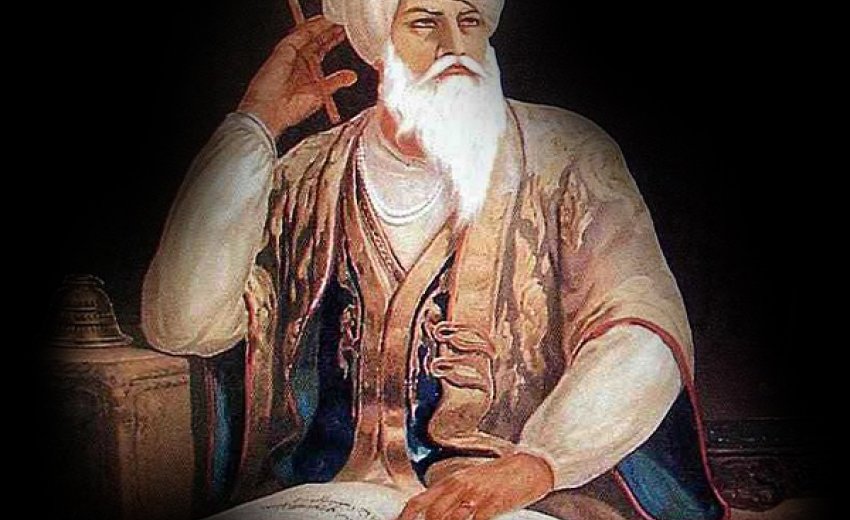In the holy city of Anandpur, Bhai Nand Lal joined a group of 52 poet-scholars who gathered before the Guru to translate ancient texts into the language of the people.
Despite being one of Guru Gobind Singh's beloved followers and having his writings recognized by the Akal Takht as important, Bhai Nand Lal doesn't seem to receive much attention from everyday Sikhs.
About Bhai Nand Lal
Bhai Nand Lal (around 1642 – 1712) was born in Ghazni, Afghanistan, where he spent his early years. His father made sure he received a thorough education, focusing on Islamic teachings. This included learning Persian and Arabic, studying the Qur’an, Hadîth, and mystical works like Hujwirî’s Kashfu’l-Mahjûb and Rumi’s Mathnavi-ye Ma’navi. As he grew, he got more interested in politics and administration, eventually taking over his father’s job as a Munshi.
However, Bhai Nand Lal's life took a different turn. After getting married and having two sons, he moved to India. There, he found work at the Mughal court in Agra, serving the crown prince Muhammad Azzam, who later became the Mughal emperor. Legend has it that Aurangzeb, the Mughal emperor, once gathered scholars to interpret a verse from the Qur’an.
Different people had different ideas about interpreting something, mixing tradition with new thoughts. But none of these satisfied the emperor, who was tired of failed attempts to explain it skillfully. Then, Bhai Nand Lal stepped forward, offering his own interpretation. When the emperor heard Bhai Nand Lal's explanation, he was so impressed that he wanted to meet him in person. Learning that Bhai Nand Lal wasn't Muslim, the emperor gave him a choice: convert or face death, thinking it a waste to have such talent go to waste as a non-Muslim. Upon hearing this, Bhai Nand Lal fled from the Mughal court at night and sought refuge in Anandpur, where he met the young Guru Gobind Singh.
Life at Anandpur
In the holy city of Anandpur, Bhai Nand Lal joined a group of 52 poet-scholars who gathered before the Guru to translate ancient texts into the language of the people. These texts covered various topics like spiritual teachings, government policies, mythology, philosophy, rhetoric, love stories, and tales of heroism. Among the poets, Bhai Nand Lal stood out not only for his mastery of Persian but also for his deep devotion to Guru Gobind Singh. Impressed by his compositions, the Guru entrusted him with sharing his works with the devotees who came from different places to seek the Guru's blessings.
In Anandpur, where thousands lived under the guidance of their Guru, Bhai Nand Lal held a special place in the Guru's heart. Many stories from the city depict how the Guru praised and honored him, often referring to him as his precious jewel. Some accounts even suggest that Bhai Nand Lal was among the closest devotees of the Guru. Interestingly, he was informed about the transition of the Adi Granth to Guruship in a private conversation in 1695, long before it was publicly announced in 1708.
The compositions of Bhai Nand Lal
Bhai Nand Lal wrote many works in classical Persian style, much like famous poets Hafez and Rumi. He used their poems to discuss Sikh beliefs compared to other traditions. In total, Bhai Nand Lal wrote 11 compositions, focusing on Sikhi's principles.
1. Diwân-E-Goya
2. Zindagînamâ
3. Ganjnamâ
4. Tankhâhnamâ
5. Jot Bigâs
6. Joti Bigâs (Punjabi)
7. Arz-Ul-Alfâz
8. Tausif-O-Sana
9. Khatimât
10. Dastûr-Ul-Insha
11. Prashanuttar
Many of his writings are in classical Persian, but some are also in Arabic and Punjabi. Sometimes, he mixes two or more languages in his compositions. Most of his works involve explanations of the Guru Granth Sahib, but he also writes beautifully in response to Persian poets from the past. Additionally, he paraphrases verses from the Qur’an and praises the 10 Gurus. In the early 20th century, the Akal Takht elevated his writings from just poetry to holy scripture in the Sikh tradition. The only other Sikh who has been honored in such a way is Bhai Gurdas.
Final Word
In today’s world, Sikhs see Bhai Nand Lal as a symbol of the spiritual side of Guru Gobind Singh. While much attention has been given to Guru Gobind Singh's warrior image, not enough has been said about his saintly side. Bhai Nand Lal and his poetry beautifully portray this gentle aspect of Guru Gobind Singh. Coming from Afghanistan, Bhai Nand Lal was a man of deep spirituality and remarkable talent in mystical writing. He deserves global recognition, similar to renowned poets like Rumi and Hafez.
As the moon merely reflects the light of the sun, likewise, Bhai Nand Lal is an eternal reflection of the majesty and tenderness of Sri Guru Gobind Singh.
*Based on an article published in The Sikh Nugget on 25th June 2012
